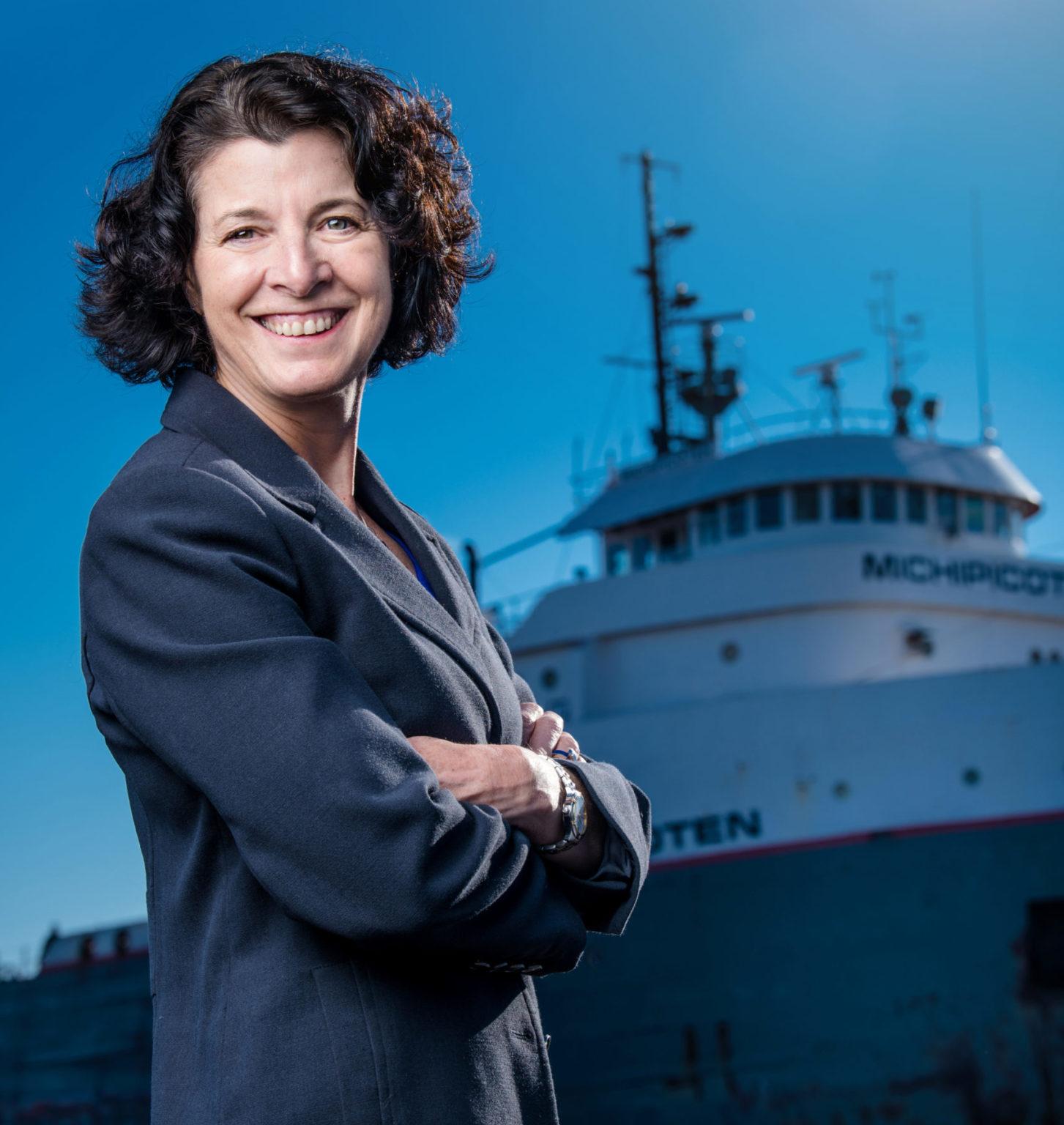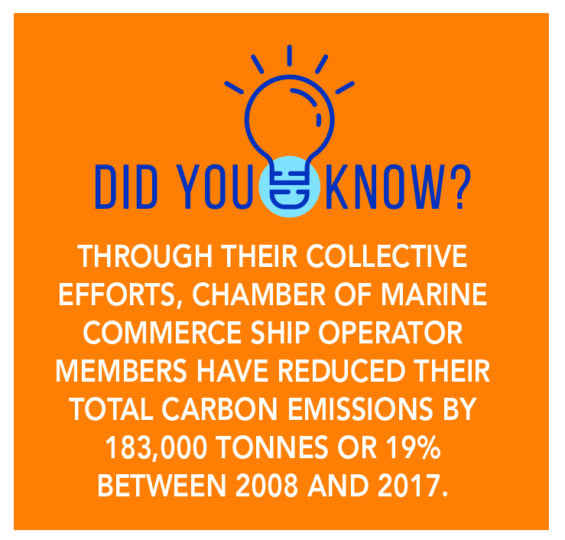
The Duluth Seaway Port Authority is the largest and furthest inland port on the Great Lakes, acting as a mid-America gateway for domestic and international trade. In an exclusive interview, Deb DeLuca, executive director, comments on competitive challenges, expansion projects, environmental policy and cargo growth.
Q: Since taking the helm of the Duluth Seaway Port Authority in August 2018, what has struck you as the biggest competitive challenges facing the Great Lakes-St. Lawrence transportation corridor?
A: My work with the Port Authority actually began in 2014, as director of government and environmental affairs, and ever since, I have been nurtured on the narrative that
“… the St. Lawrence Seaway is only 50% utilized…,” which generates the eternal question: what are the barriers to increasing System use?
For the Port of Duluth-Superior, the furthest inland port in the system, any extraordinary costs compound over the 2,340-mile journey. Pilotage rates are a contributor to higher costs and create a significant competitive disadvantage as compared to traditional coastal ports – we hear about it from agents, customers, and cruise lines. This has been discussed often, and it bears repeating that pilotage reform is needed to level the playing field. In order to be effective, it should be approached through a collaborative, transparent process involving the U.S. Coast Guard, maritime stakeholders and the pilot organizations in both the United States and Canada.
We must find a solution that, long-term, is beneficial for all, but we haven’t yet found the forum for that process. Additionally, we must also continue to invest in infrastructure renewal, repair and improvement throughout the waterway and its nodes. Looking to the future, the Great Lakes-St. Lawrence system will be at a disadvantage without a more advanced vessel traffic system utilizing ship-to-shore data sharing that optimizes vessel movements and improves system efficiency; this will need to be right-sized to the system and will likely need to be adopted incrementally.
Q: During your time with the Port Authority, the Port of Duluth-Superior completed $22.5 million USD in infrastructure renewal projects, opened the CN Duluth Intermodal Terminal and launched the Duluth Cargo Connect initiative. What new expansion projects are underway or planned, and is there sufficient space for these developments?
A: Our organization experienced a great deal of positive change under Vanta Coda’s administration and I’m proud to have been a member of his executive team. We accomplished some major projects prior to his departure to the Ports of Indiana in 2017.
I identified two immediate orders of business on becoming executive director eight months after Vanta left. The first was to stabilize the organization (we needed to complete three hires to backfill my position and two others) and cement relations with our board of commissioners. The second was to implement the initiatives that started under Vanta so that we fully optimized those opportunities.
That said, last June we did complete a $3.3 million expansion of the CN Duluth Intermodal Terminal, which was in part funded by a grant ($2.2M) that I had coordinated while in my former position. We have plans (and grant applications) in place to add 50,000 feet of warehouse space and rebuild two dock walls totaling 1,800 lineal feet at the Clure Public Marine Terminal. We are also building out 5-6 acres of secured outdoor storage space for our tenants to free up room at the Clure for Duluth Cargo Connect operations. Finally, we are in the process of rehabilitating a 1910-vintage building near the Clure Terminal to become the new Duluth Seaway Port Authority office.

Q: Cargo diversification has emerged as an increasingly significant feature of port commercial strategy to consolidate the present and build the future. Please describe how your team is seeking to broaden the variety of cargoes within its catchment area, including the movement of container cargo of all types via rail and road.
A: We’ve been very active in this realm. We are an economic development agency and we have two goals that are inextricably linked. We seek to develop and operate our assets in a way that provides supply chain cost savings to regional industries to keep them competitive in the global marketplace. Also, we seek to increase cargo diversity through our terminal, and through the port. Our agent (Lake Superior Warehousing) and our staff work closely with regional industries to help develop these opportunities.
Our operation of the intermodal terminal, including our value-added services, has enabled regional industries to save up to a third on their freight costs. We have customers who are exporting finished product for the first time, as well as customers who are able to reach markets that they couldn’t before. All of these examples represent new cargos through our terminal, but they also represent increased trade for the region. In all, we touched six continents with our Duluth Cargo Connect efforts and the Clure Public Marine Terminal in 2019.
Q: From your background and previous tasks at the port, environmental issues figure very high in your priorities, as recognized by DSPA’s strong performance in a report last June by the environmental improvement organization, Green Marine.
A: DSPA joined the voluntary Green Marine certification program in 2007 to provide a tangible scoreboard for environmental stewardship. By design, the program has grown in complexity and membership over the past 14 years with specific metrics for environmental performance, including greenhouse gas emissions, aquatic invasive species, waste management, spill prevention and community impacts.
We are proud to rank among Green Marine’s top 5 port authorities in the United States. In 2020, we continue to be proactive about minimizing environmental impact of our operations and overall maritime commerce. Specifically, we are expanding the complexity of greenhouse gas emissions tracking from our terminal and will set specific reduction goals. From a broader industry perspective, we are focused on aquatic invasive species threats by leading the Great Waters Research Collaborative (GWRC) Advisory Committee at Lake Superior Research Institute.
Q: Close relations between port authorities and local municipalities represent an important factor for mapping the future. How would you describe the current community relations?
A: We work closely with the City of Duluth on several issues and I feel we have a strong relationship with the city. It’s best to seek commonalities in goals, concerns and desired outcomes and then build from there. The city undertook a revision of its Comprehensive Land Use Plan in 2015 and we participated very deliberately to make sure that the need for the industrial sector in the city’s economy was well understood. We did so in a respectful manner, and in fact, contracted a study to gather a set of neutral facts on this topic. I feel that our efforts in this area have helped change the narrative surrounding industrial land use in our city.
Q: During the winter months, Coast Guard services on Lake Superior are vital to ensure safe and efficient navigation. Is there sufficient sufficient icebreaker capacity (from both U.S. and Canadian coast guards)?
A: It’s no secret that the U.S. Coast Guard is challenged by a lack of icebreaking resources dedicated to Lake Superior and the Great Lakes as a whole. The Alder’s home port is Duluth- Superior, but Alder is aging and she isn’t a heavy icebreaker. Only the Mackinaw can serve a heavy icebreaking role, and the demands on that one vessel, operating out of Cheboygan, Michigan, are extensive.
The U.S. Coast Guard deserves huge appreciation and extra kudos for getting the 2019 season underway given the difficult conditions; they did so through shrewd deployment of available resources, careful sequencing and long hours. But beyond the appreciation and kudos, they also deserve congressional support for additional funding dedicated to Great Lakes icebreaking resources. With more robust icebreaking resources, our Coast Guard can open that lane and keep it open with even greater success in the future. In the meantime, we’re hopeful that the existing U.S. Coast Guard assets can endure, and we’re appreciative of any assistance provided by the Canadian Coast Guard.